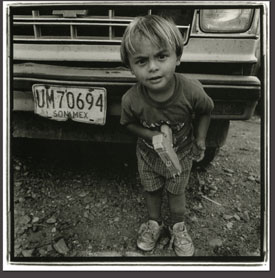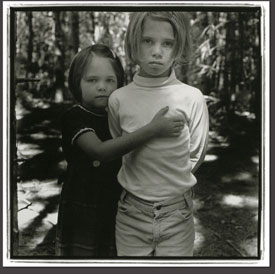| ||||
‘Convergence’ at the Open Shutter
by Jules Masterjohn For artists, naming a piece or collection of work can be a daunting task. Attaching a word or phrase to something intended to communicate through visual means often forces an artist to walk a subtle line. Photographer Gloria Baker Feinstein has taken a simple approach to this predicament. She chose one word to speak for her traveling exhibition of images and the book that accompanies it: “Convergence.” Although a simple title, it assumes complexity, something that permeates the exhibition. On display at Open Shutter Gallery, “Convergence” is a selection of Feinstein’s black-and-white photographs that highlight the subtle mystery held within the everyday. What converges in the photographer’s lens are the suggestive and the sublime, the unknown within the familiar. Feinstein accomplishes this by working in portraiture, a genre that is both common in that it represents humans, but unique, due to the individuality described. By choosing children as her subjects, the viewer is immediately comfortable approaching her photographs. Yet when he or she stops to take a closer look, the images hint at small oddities. Through Feinstein’s compositions, scenarios or the psychological stance of her subject, she creates quirky photographs with sometimes disturbing implications. Regardless of the mechanism, Feinstein’s photographs present uncertain narratives and make for a provocative viewing experience. In “Amilia, Missouri, 2000,” Feinstein employs strong design elements to help substantiate the ambiguity of the image. The composition is divided into three vertical portions. The action of the photo takes place in the left third of the composition with the young girl, Amilia, perched on a swing. The photo was taken moments before her upper body moves out of the frame, her legs having already exited. The center of the photo is comprised of an urban backyard and is, for all purposes, the scenic background. On the far right, as a balance to the activity of Amilia, is the wooden structure of the swing set with only a child’s small leg visible atop it. All body parts are accounted for, yet not from the same child, and this creates a perplexing scene. Feinstein is true to her medium – she prints her photographs as they were composed in the camera. Creating her compositions through cropping in the viewfinder versus the darkroom, she demonstrates her in-the-moment design skills. Not all photographers use their cameras to select the final image we see; many make this determination in the printing process by cropping the image. The telltale sign of an image that has been printed as it was photographed is the black border around the edge, as is seen in Feinstein’s photographs. Many photographers leave the edge of their negative visible as evidence that what they saw is what we see.
In “Boy With Toy Gun, New Mexico, 1996,” Feinstein shows us her ability to coax maturity from a child. Leaning toward the photographer, and thus the viewer, the young boy compels us with his demanding stare, a mouth poised to speak and his retreating but open hand. What words flew from his lips just after the shutter snapped? Inherent in Feinstein’s work is ambiguity. Her “Madison Sisters, Wisconsin, 1979,” is suggestive and begs many interpretations. A loss of innocence is projected by their apprehensive expressions and is reinforced by their protective posturing. Margy Dudley, owner and gallery director of Open Shutter, writes, “Gloria has been in love with photography and used a camera since she was 3 years old, starting with an original Kodak Brownie. Today she uses a Hasselblad and develops all of her work in a traditional darkroom setting. It is clear that some of the well known photographers who have influenced her work include Diane Arbus, Keith Carter and Sally Mann as well as Andre Kertesz.” In the work of each of these celebrated photographers, there is a quality that invites us into a world in which we are not simply an observer. Good art, whether contemporary or traditional, brings together the artist’s vision and our understanding to co-create meaning, leaving room for varied interpretation. Art happens during this convergence, and Feinstein’s photographs open a door inviting us to enter. • “Convergence” is on display through Wed., March 12, at the Open Shutter Gallery, 755 E. Second Ave., in Durango. |



